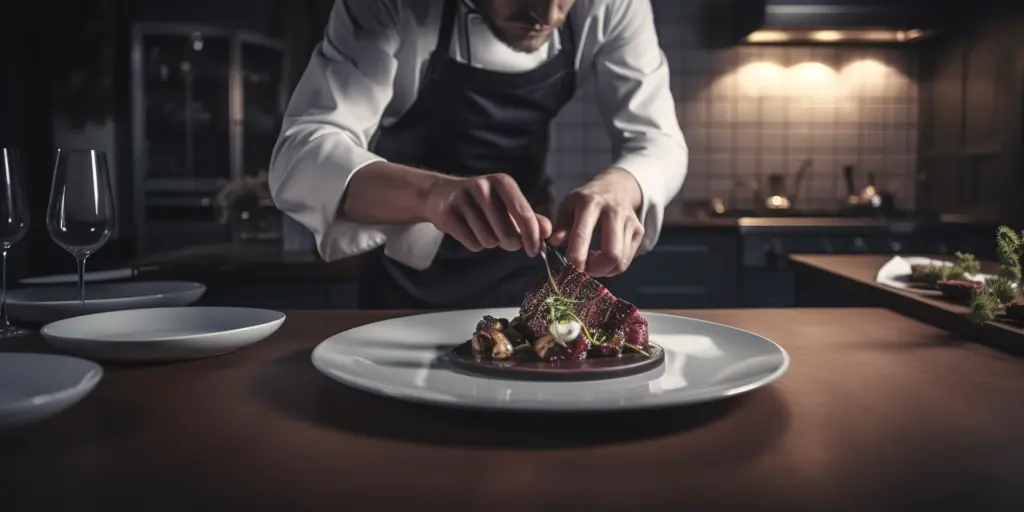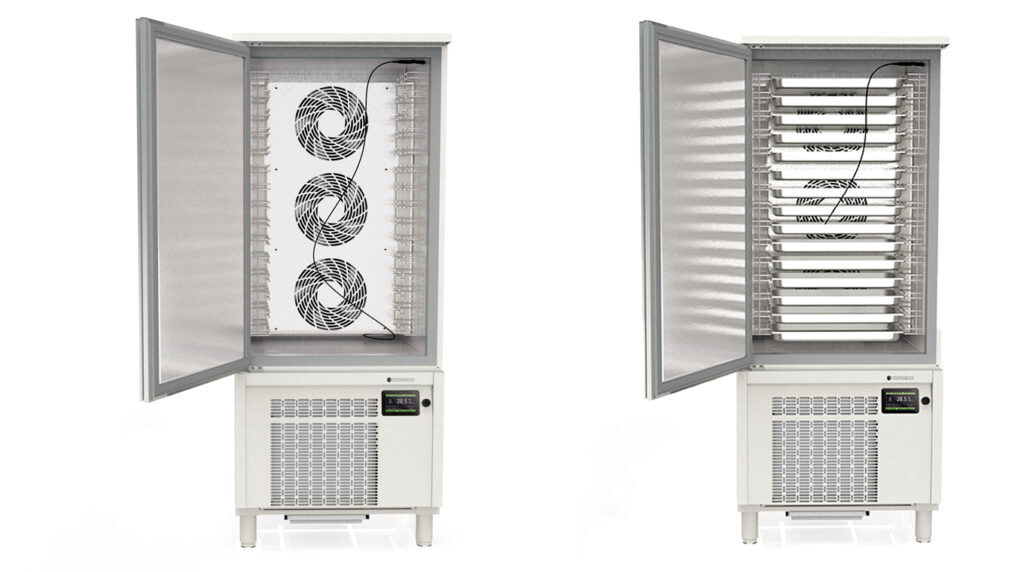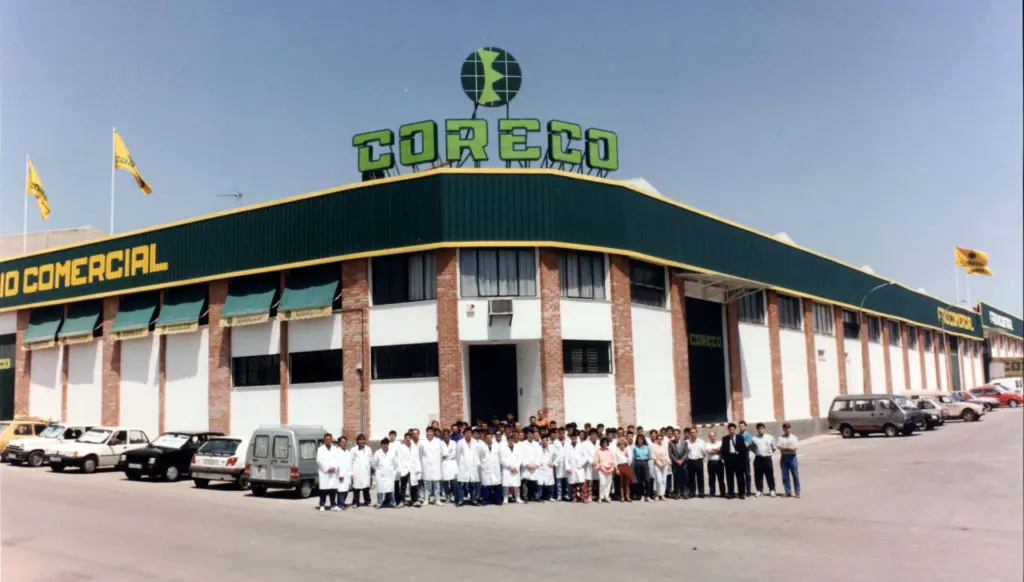At Coreco, we understand the importance of maintaining food quality and safety in any professional kitchen. A blast chiller is an essential tool that allows chefs and restaurants to better manage their ingredients, reduce food waste and improve operational efficiency.
In this guide we want to give you some insight into the essentials you need to know about blast chillers, their benefits, and how Coreco models can transform your kitchen.
What is a Temperature Chiller?
Definition and Functioning
A blast chiller is a professional refrigeration cabinet capable of rapidly lowering the temperature of freshly cooked or fresh food, thus preventing the growth of bacteria. This blast chilling process maintains the full properties of the food, such as freshness, quality, texture, taste and smell. This refrigeration process has become an excellent option for restaurant kitchens or central kitchens, providing greater agility and profitability in services.
Differences between Blast Chillers and Traditional Freezers
Fast Freeze vs. Slow Freeze
Blast chillers use fans to provide cold air, allowing room temperature or even hot food to be cooled quickly, without affecting other frozen products. Blast freezing cools the core of the food directly, creating small ice crystals that do not damage tissue, unlike slow freezing in traditional freezers, which forms large, destructive crystals.
Advantages of Temperature Chillers
- Hygiene and SustainabilityThe blast chillers combat bacterial growth and reduce leftovers and waste.
- ExampleIn a restaurant, blast chillers allow cooked food to be cooled quickly, reducing the risk of bacterial growth and ensuring food safety. This is especially important for dishes such as soups and stews which, when cooled quickly, can be safely stored for later consumption.
- Health regulations are extremely IMPORTANT in any professional kitchen and blast chillers play a key role in meeting these standards.
- The Coreco Temperature Chiller complies with all HACCP and food safety standards and, at the same time, helps to avoid the risks of dehydration and frost formation, in the blast chilling or freezing mode.
- Conservation QualityThey prevent the formation of macrocrystals, preserving all the qualities and properties of the food.
- ExampleIn a bakery, using a blast chiller to rapidly cool bread and pastry doughs ensures that the texture and flavour remain intact. Preventing the creation of ice macrocrystals in the bread fibres will result in a fresher and better quality end product.
- Saving Time and MoneyThey allow meals to be planned and prepared/preserved in advance.
- ExampleTemperature controllers also help to reducing food wasteThey allow chefs to prepare large quantities of food in one go, preserving it for longer without compromising its quality. This is very beneficial for kitchens with a high production volume.
- Minimisation of Moisture LossRapid cooling reduces moisture loss and food shrinkage.
- ExampleIn the ice cream industry, using a blast chiller ensures that ice creams and sorbets maintain a smooth and creamy texture by preventing the formation of large ice crystals that can affect the quality of the product.
Downward Cycles
Rapid or Positive Abatement
Known as Blast Chilling, this cycle reduces the core temperature of the products from +90°C to +3°C very quickly, in less than 90 minutes. It is then able to maintain them at a temperature between 0°C and +5°C, depending on the value set for their preservation. Within this range, there are two types of abatement:
- Soft ChillingIdeal for delicate foods such as fish and seafood. For example, sushi and sashimi benefit from this type of dewatering because it maintains their texture and flavour without compromising their freshness.
- Hard ChillingPerfect for fatty and dense products such as meats and thick sauces. For example, a bolognese sauce or a piece of roast meat is kept in optimum condition by being cooled quickly, preserving its flavour and consistency.
Blast Freezing or Negative Freezing
This cycle is capable of reducing the temperature of a product to the ideal negative conservation temperature of the product. It can start with a core product temperature of +20ºC or +90ºC and go as low as -18ºC. This process avoids the appearance of macrocrystals and maintains the quality of the product for its final consumption.
- Example of UseProducts such as ice cream and sorbets benefit greatly from this process. Rapid freezing ensures that microcrystals are formed, resulting in a smooth, creamy texture without unpleasant granules.
Types of Chillers according to their Capacity
Compact Freezers
Ideal for small restaurants and catering businesses with limited space. These table-top trays usually have a capacity of 3 to 4 GN 1/1 trays of 60 x 40 cm.
- Example of UseA café offering bakery products can use a compact blast chiller to rapidly cool freshly baked cakes and pies, ensuring they are ready for decoration and sale in a short time.
Tables Chests of drawers
Recommended for restaurants with a medium-high production volume. Their usual capacity is 5 to 6 GN1/1 trays of 60 x 40 cm.
- Example of UseA restaurant with a varied menu can prepare main dishes and side dishes in large quantities, using the chiller table to cool and store these foods safely until they are ready for service.
Cabinet racks
Suitable for high performance industrial kitchens. Their usual capacity is from 8 to 16 GN 1/1 trays of 60 x 40 cm.
- Example of UseIn a large hotel kitchen, a chiller cabinet can quickly cool large batches of food prepared for events and banquets, ensuring everything is ready and fresh for diners.
Trolley Chutes
These floor-standing vertical blast chillers are aimed at very high production catering businesses. Their usual capacity is 20 GN 1/1 (60 x 40 cm) or 2/1 (80 x 60 cm) trays.
- Example of UseIn a catering kitchen for mass events, a chiller for trolleys enables the rapid cooling of large quantities of food on trays, facilitating logistics and ensuring the quality of the products until they are delivered.
Special Freezer Blast Chillers for Ice Cream Parlours
These blast chillers reach -40 ºC and have two operating modes: by time or by probe. Their usual capacity is 6, 12, 28 or 44 trays measuring 36 x 16.5 x 12 cm.
- Example of UseA craft ice cream parlour can use these blast chillers to produce large batches of ice cream in different flavours, ensuring that each batch retains its smooth texture and superior quality.
Benefits of Temperature Chillers Coreco
As we have explained, blast chillers perform rapid and uniform cooling to preserve the organoleptic qualities and nutritional values of foods, prolonging their shelf life, making them a necessary tool for the catering professional.
- Hygiene and Safety
- Rapid temperature reduction prevents the reproduction of micro-organisms in food, improving food safety.
- Example: A hospital that prepares meals for patients can ensure that all food is kept free of dangerous bacteria through the use of blast chillers.
- Rationalisation of Labour
- They allow the preparation of large quantities of product which, once slaughtered, can be consumed within 5-7 days or frozen for several months.
- ExampleA school with a canteen can prepare and break down large quantities of food, ensuring safe and quality food for students throughout the week.
- Time Savings
- They make it easier to prepare food in advance and offer a more varied menu, increasing production capacity and reducing personnel costs.
- ExampleA restaurant with high customer turnover can prepare and serve popular dishes in large quantities, ensuring fast and efficient service during peak hours.
- Quality
- Rapid freezing promotes the formation of microcrystals, maintaining product characteristics over time.
- ExampleA gourmet food supplier can use blast chillers to maintain the premium quality of its products during storage and transport.
- Applications
- Useful for all types of catering, especially in canteens, hospitals, hotels, restaurants and large banquets.
- ExampleA hotel that organises large banquets can use blast chillers to ensure that all dishes served maintain their quality and freshness.
- Other advantages
- They optimise stock management, enable larger purchases at better prices and better organise stocks, drastically reducing waste.
- ExampleA central kitchen can use blast chillers to extend the shelf life of perishable products, reducing waste and improving profitability. This allows for better organisation of inventories and provides customers with high quality products for longer.
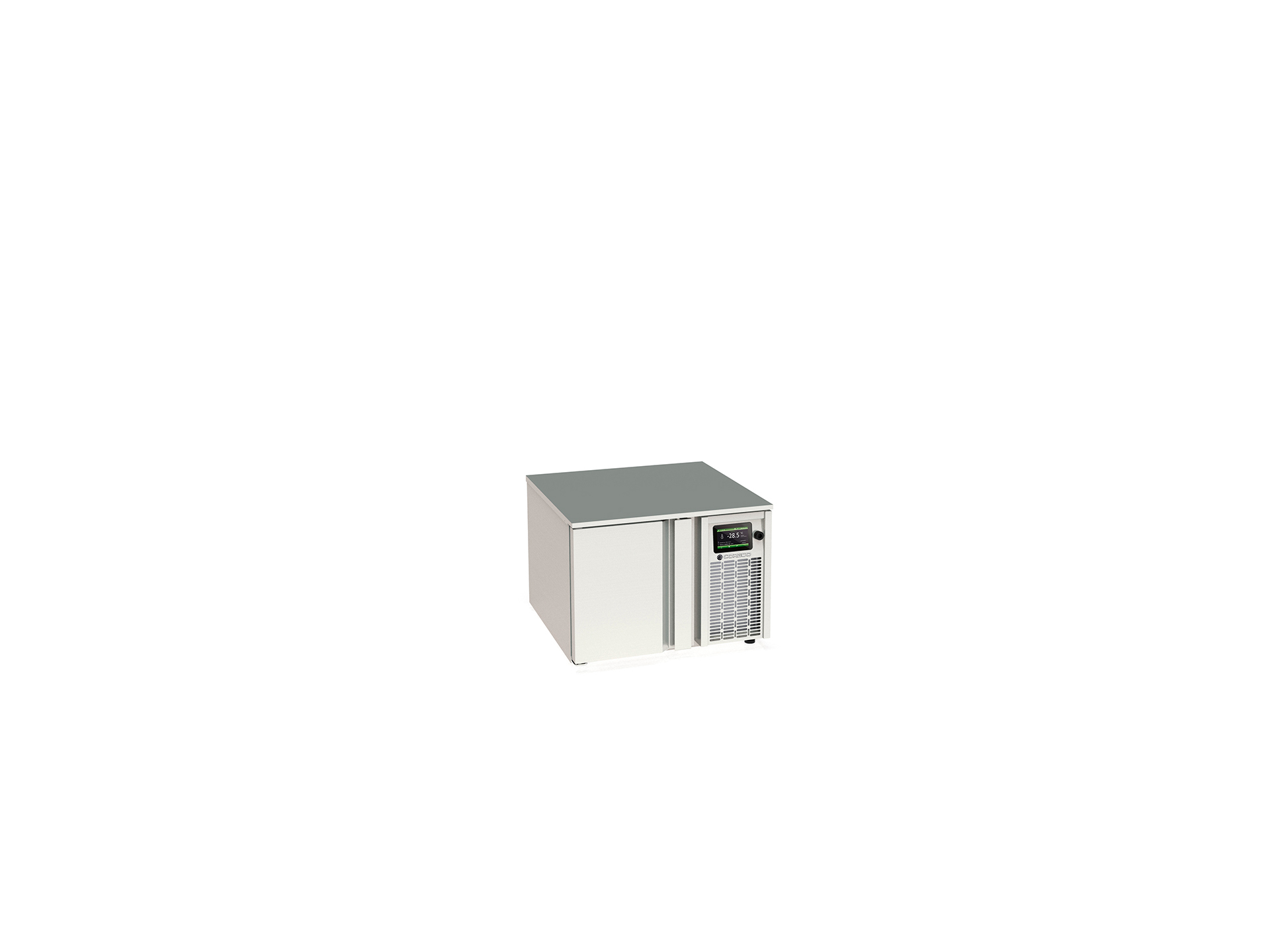
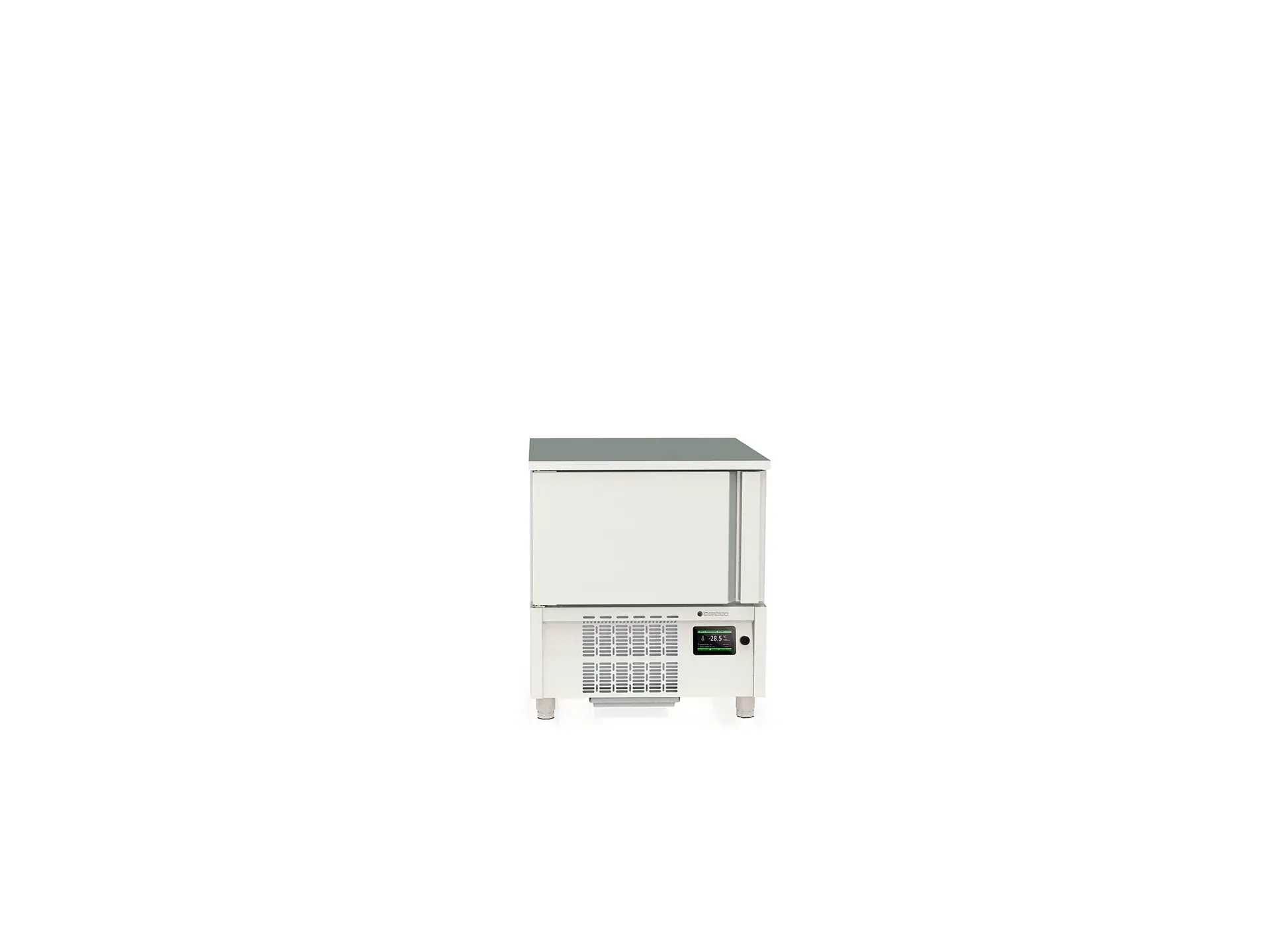
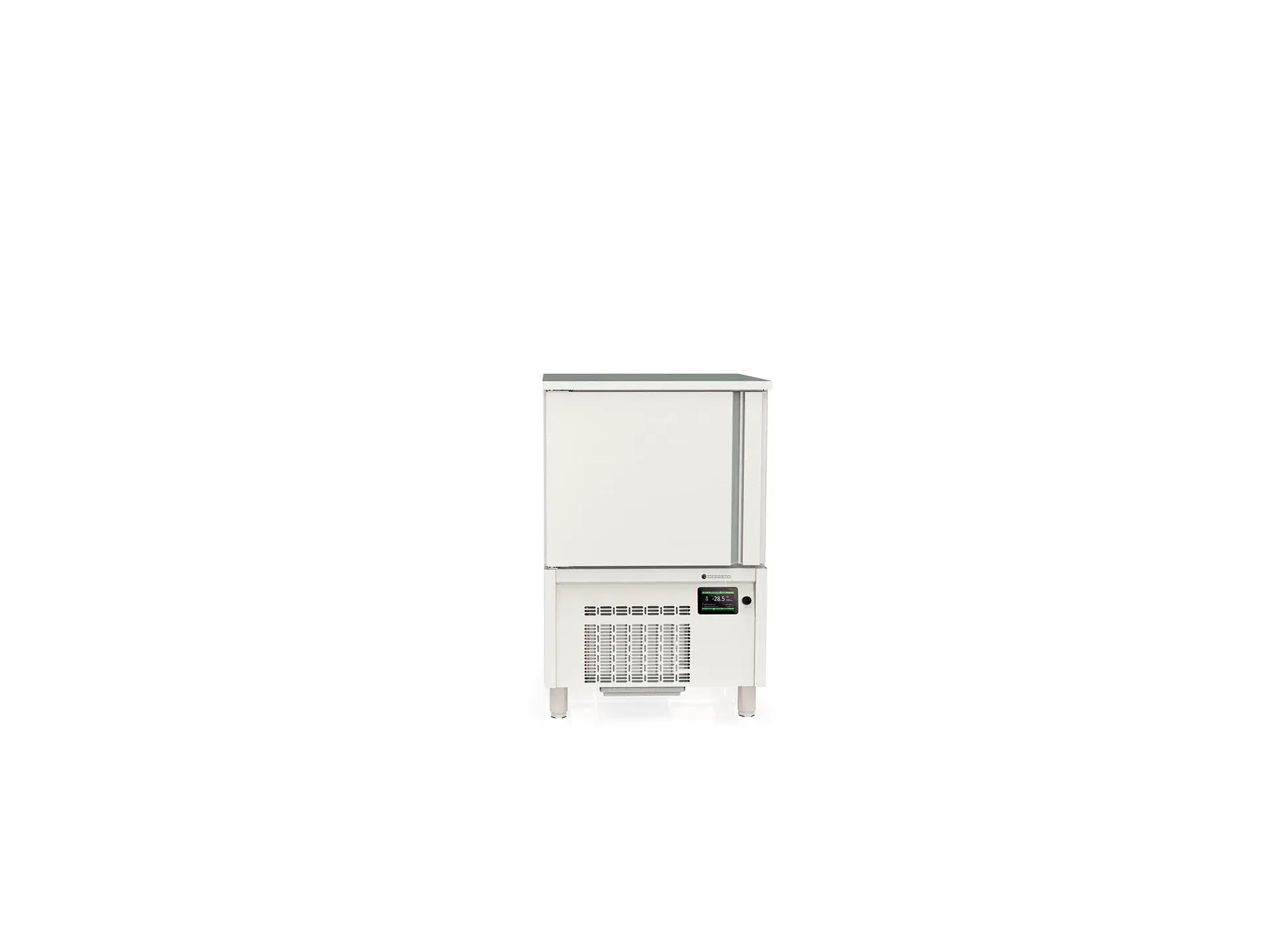


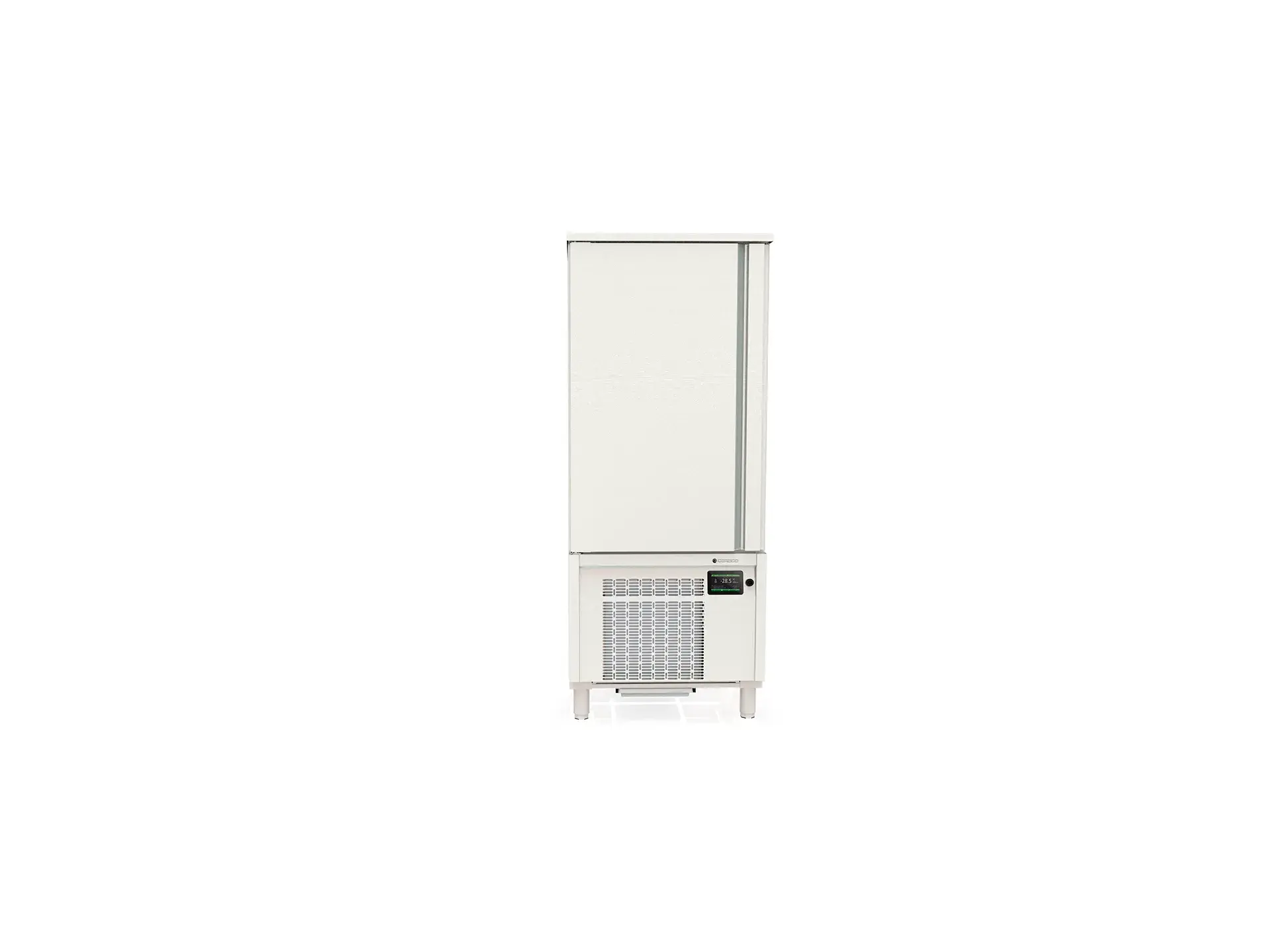
Coreco Advanced Temperature Chiller Technology
Air Circulation Systems
Coreco blast chillers are equipped with optimised air circulation systems that ensure uniform cooling of all foods. This system significantly reduces the time needed to reach the desired temperatures, improving the operational efficiency of the kitchen.
Intelligent Control Interface
The graphical touch screen interface allows users to program and adjust cooling and freezing cycles with precision. This not only improves operational efficiency, but also ensures that each type of food is optimally cooled. Intuitive icons provide easy access to the numerous functions for optimal management of each process.
High Quality Construction and Materials
Coreco chafers are constructed from high quality materials that guarantee durability and strength in demanding kitchen environments. The robust design ensures consistent and reliable performance, ideal for any professional kitchen.
Downward Cycles
Rapid or Positive Abatement
Known as Blast Chilling, this cycle reduces the core temperature of the products from +90°C to +3°C very quickly, in less than 90 minutes. It is then able to maintain them at a temperature between 0°C and +5°C, depending on the value set for their preservation. Within this range, there are two types of abatement:
- Soft ChillingIdeal for delicate foods such as fish and seafood. For example, sushi and sashimi benefit from this type of dewatering because it maintains their texture and flavour without compromising their freshness.
- Hard ChillingPerfect for fatty and dense products such as meats and thick sauces. For example, a bolognese sauce or a piece of roast meat is kept in optimum condition by being cooled quickly, preserving its flavour and consistency.
Blast Freezing or Negative Freezing
This cycle is capable of reducing the temperature of a product to the ideal negative conservation temperature of the product. It can start with a core product temperature of +20ºC or +90ºC and go as low as -18ºC. This process avoids the appearance of macrocrystals and maintains the quality of the product for its final consumption.
- Example of UseProducts such as ice cream and sorbets benefit greatly from this process. Rapid freezing ensures that microcrystals are formed, resulting in a smooth, creamy texture without unpleasant granules.
Types of Temperature Chillers by Capacity
Compact Freezers
Ideal for small restaurants and catering businesses with limited space. These table-top trays usually have a capacity of 3 to 4 GN 1/1 trays of 60 x 40 cm.
- Example of UseA café offering bakery products can use a compact blast chiller to rapidly cool freshly baked cakes and pies, ensuring they are ready for decoration and sale in a short time.
Tables Chests of drawers
Recommended for restaurants with a medium-high production volume. Their usual capacity is 5 to 6 GN1/1 trays of 60 x 40 cm.
- Example of UseA restaurant with a varied menu can prepare main dishes and side dishes in large quantities, using the chiller table to cool and store these foods safely until they are ready for service.
Cabinet racks
Suitable for high performance industrial kitchens. Their usual capacity is from 8 to 16 GN 1/1 trays of 60 x 40 cm.
- Example of UseIn a large hotel kitchen, a chiller cabinet can quickly cool large batches of food prepared for events and banquets, ensuring everything is ready and fresh for diners.
Trolley Chutes
These floor-standing vertical blast chillers are aimed at very high production catering businesses. Their usual capacity is 20 GN 1/1 (60 x 40 cm) or 2/1 (80 x 60 cm) trays.
- Example of UseIn a catering kitchen for mass events, a chiller for trolleys enables the rapid cooling of large quantities of food on trays, facilitating logistics and ensuring the quality of the products until they are delivered.
Temperature controller for ice cream parlour
These blast chillers reach -40 ºC and have two operating modes: by time or by probe. Their usual capacity is 6, 12, 28 or 44 trays measuring 36 x 16.5 x 12 cm.
- Example of UseA craft ice cream parlour can use these blast chillers to produce large batches of ice cream in different flavours, ensuring that each batch retains its smooth texture and superior quality.
A bit of history
Historical Background of Refrigeration
The history of the blast chiller cannot be attributed to a single inventor, but stems from decades of advances in refrigeration technology. From the 19th century onwards, pioneers such as William Cullen, Thomas Moore, Oliver Evans and Jacob Perkins laid the foundations with the first vapour compression refrigeration systems.
Contributions in the 19th century
In 1842, the American physician John Gorrie created a working prototype of a refrigeration system to cool yellow fever patients. Although his invention was not commercially successful, it marked a significant milestone in the history of modern refrigeration.
Innovations in the 20th Century
French engineer Charles Tellier, in 1858, built the first industrial refrigeration machine, using ammonia as a refrigerant, which represented a major breakthrough in industrial cooling capacity.
During the 20th century, advances in refrigeration and freezing systems continued, thanks to leading figures such as Alfred Mellowes, Nathaniel B. Wales and General Electric, who perfected key technologies that boosted the efficiency and reliability of these systems.
Coreco responds
If you want to transform the way you prepare and preserve food in your professional kitchen, contact us at Coreco to find out more about our blast chiller models and how they can help you keep your dishes looking freshly cooked.
Temperature Chiller: A good investment
Blast chillers are an essential investment for any professional kitchen looking to improve food quality and safety, reduce waste and increase operational efficiency. Coreco models, with their advanced technology and robust design, offer customised solutions for every type of kitchen.
At Coreco we offer the highest quality equipment to meet the needs of the most demanding chefs and restaurants. Feel free to contact us to find out more about our blast chillers or any other refrigerator in our Gourmet range and how they can benefit your business.
If you would like to learn more about our advanced solutions for gourmet spaces and how they can improve the quality of your products or have a premium presentation in your venue, download our catalogue and discover all that Coreco has to offer. You can also contact our sales team for personalised advice.
